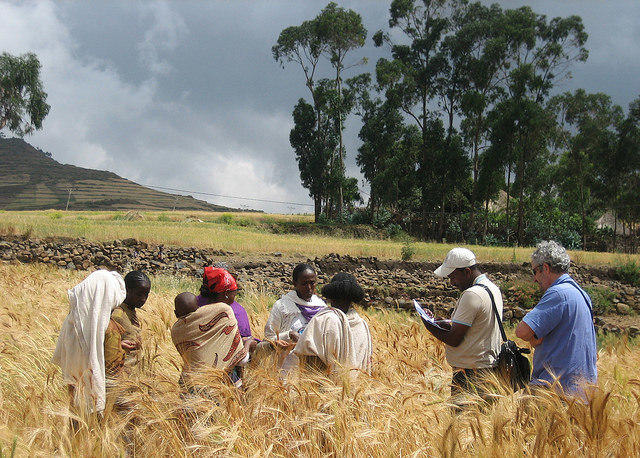Tracking proteins in farmers' varieties of durum wheat in Ethiopia

Durum wheat is a common crop in Ethiopia where many local varieties are grown. Mr Basazen Fantahun, an Ethiopian, has been awarded Bioversity International’s Vavilov-Frankel Fellowship to study the quality of 35 farmers' varieties of durum wheat used for pasta making.
Durum wheat, a basic ingredient of pasta, couscous and bread, is widely grown in Ethiopia’s highlands where it was introduced some 5000 years ago. Farmers grow many local varieties of durum wheat (Triticum turgidum ssp. durum) as a result of both natural evolution and farmers’ domestication. Today, due to shifting rainfall and increasing temperature, cultivation of durum wheat requires greater diversity of traits which would in turn provide options for adaptation to new conditions.
The global durum wheat sector, meanwhile, prefers modern varieties with strict quality parameters, (i.e., protein content and gluten quality). Modern breeding technologies can achieve this, but it depends on a steady supply of 'fresh' genetic diversity with interesting traits.
Farmers' varieties, such as those grown by Ethiopian farmers, could have crucial roles in breeding programmes if their traits were better known. Mr Basazen Fantahun, a researcher at the Ethiopian Biodiversity Institute (EBI), has been awarded Bioversity International’s Vavilov-Frankel Fellowship (VFF) 2015 to do exactly that. The one-year fellowship will support his study on 'Quality and diversity assessement in farmers' varieties of Ethiopian durum wheat (Triticum turgidum ssp. durum)'.
Mr Basazen has a MSc in plant breeding from Haremaya University, Ethiopia, and has previously studied the species during the EBI project 'Using local durum wheat and barley diversity to support the adaptation of small-scale farmer systems to a changing climate in Ethiopia'. Supervised by Bioversity International’s Carlo Fadda, Mr Bazasen will screen 35 farmers’ varieties of durum wheat for desirable qualities for pasta making, in particular the protein gliadin. Secondly, he will describe and examine the genetic diversity of farmers’ varieties of Ethiopian durum wheat, spending a period at the advanced laboratory at Biosciences eastern and central Africa - International Livestock Research Institute (BecA - ILRI) Hub, Nairobi, Kenya.
During his fellowship, Mr Bazasen will be working closely with Bioversity International's 'Seeds for Needs' initiative, which introduces new seeds to farmers and uses crowd-sourcing methods to evaluate these seeds (farmers reporting back to scientists using mobile phones). The result of his research will complement other Bioversity International projects in Ethiopia and will give farmers and breeders better ground for decisions on which varieties to grow, or what materials to use in breeding programmes.
The Fellowship is supported by the Grains Research and Development Corporation (GRDC), Australia.
Photo: Farmers giving feedback to researchers about their preferred traits of durum wheat varieties, Ethiopia. Credit: Bioversity International/C. Fadda
